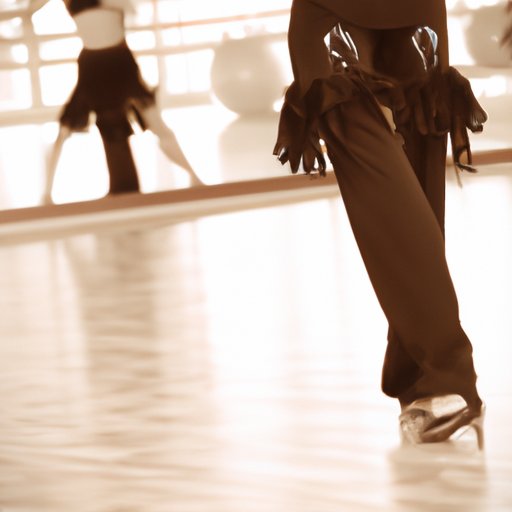Introduction
Competitive ballroom dancing is an art form that has been around for centuries. It combines the grace of ballet, the energy of jazz, and the passion of Latin dance. From the glittering gowns to the intricate footwork, it is a sport that captivates audiences everywhere. This article is designed to help readers begin their journey into competitive ballroom dancing and offers tips on finding a partner, researching competitions, selecting a dance style, finding a good instructor, basics of ballroom dancing, and staying motivated.
Steps to Getting Started
The first step to getting started in competitive ballroom dancing is finding a partner. While it’s possible to compete as a solo dancer, most competitions require partners. Finding someone who is compatible and committed to the same level of practice and competition is key. It’s important to remember that ballroom dancing is a team effort and requires trust and communication between partners.
Once you’ve found a partner, the next step is researching competitions. There are many different types of competitions, from local events to international championships. It’s important to research the different levels of competition, rules, and regulations before registering for a competition. This will help you to know what to expect and give you an idea of how much time and money you’ll need to invest in training and competing.
After researching competitions, the next step is selecting a dance style. There are many different types of ballroom dances, each with its own unique set of steps and techniques. Some of the most popular styles include waltz, tango, foxtrot, cha cha, rumba, samba, and swing. It’s important to select a style that both partners feel comfortable with and enjoy.
Different Types of Ballroom Dance Styles
When selecting a dance style, it’s important to understand the differences between them. Waltz is a graceful, romantic dance that is characterized by slow, sweeping movements and long pauses. Tango is a passionate and intense dance that emphasizes strong staccato movements and sharp turns. Foxtrot is a light and elegant dance that features quick, controlled steps and gliding movements. Cha cha is a lively and flirtatious dance that focuses on sharp, rhythmic steps. Rumba is a sensuous and romantic dance that incorporates fluid body movements and slow, sultry hip motions. Samba is a vibrant and energetic dance that features fast, bouncy steps and exaggerated hip movements. Swing is a fun and upbeat dance that focuses on fast-paced footwork and dynamic spins.
It’s important to choose a style that both partners are comfortable with and enjoy. According to a study conducted by the University of Oxford, “the most successful partnerships were those in which both partners had a similar level of enthusiasm for their chosen dance style.”
Finding a Good Instructor
Once you’ve selected a dance style, the next step is finding a good instructor. Good instructors should have experience teaching competitive ballroom dancing, as well as a deep knowledge of the various dance styles. They should also be able to provide helpful advice on technique and performance. Additionally, they should be able to prepare you for competitions, both physically and mentally.
When looking for an instructor, it’s important to do your research. Talk to other dancers and ask for recommendations. Read reviews and check out websites and social media pages. Make sure to meet with potential instructors to get a better feel for their teaching style and whether or not they’re right for you.
Basics of Ballroom Dancing
Once you’ve found an instructor, it’s time to learn the basics of ballroom dancing. This includes learning the steps and positions, as well as the etiquette of ballroom dancing. Steps and positions are the core of any ballroom dance and are essential for executing complex patterns and sequences. Etiquette is also important, as it helps to ensure that everyone on the dance floor is aware of and respects each other.

Staying Motivated and Practicing Regularly
One of the biggest challenges of competitive ballroom dancing is staying motivated and practicing regularly. It takes a lot of dedication and hard work to become a successful competitive dancer. To stay motivated, it’s important to set realistic goals and reward yourself for achieving them. It’s also important to surround yourself with positive people who can support and encourage you.
Regular practice is essential for improvement. According to a study conducted by the University of Manchester, “regular practice can lead to significant improvements in technique, performance, and overall enjoyment of the sport.” Set aside time each week to practice and focus on improving your technique and performance.
Conclusion
Competitive ballroom dancing is a beautiful art form that requires dedication, hard work, and perseverance. This article has outlined the steps readers can take to get started, including finding a partner, researching competitions, selecting a dance style, finding a good instructor, learning the basics of ballroom dancing, and staying motivated. With the right attitude and commitment, anyone can embark on a journey into the world of competitive ballroom dancing.
If you’re ready to take the plunge and start your journey into competitive ballroom dancing, don’t wait any longer. Take the first step today and start learning the basics. With a little bit of hard work and dedication, you’ll be on your way to becoming a successful competitive dancer.
(Note: Is this article not meeting your expectations? Do you have knowledge or insights to share? Unlock new opportunities and expand your reach by joining our authors team. Click Registration to join us and share your expertise with our readers.)
